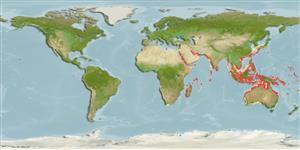Teleostei (teleosts) >
Carangaria/misc (Various families in series Carangaria) >
Sphyraenidae (Barracudas)
Etymology: Sphyraena: Greek, sphyraina, -es = the name of a fish (Ref. 45335).
More on author: Klunzinger.
Environment: milieu / climate zone / depth range / distribution range
Ecology
Marine; pelagic-neritic; depth range 1 - 50 m (Ref. 122825). Subtropical; 30°N - 33°S, 28°E - 179°E
Indo-Pacific: from East London, South Africa to Iraq, east to Fiji. Mediterranean: Lessepsian migrant.
Length at first maturity / Size / Weight / Age
Maturity: Lm 19.3 range ? - ? cm
Max length : 32.2 cm TL male/unsexed; (Ref. 94840)
Dorsal spines (total): 6; Dorsal soft rays (total): 9 - 10; Anal spines: 2; Anal soft rays: 9. Dusky band from snout through center of eye and above pectoral base to caudal peduncle, the band may be yellowish on the head; caudal fin yellow, upper and trailing edge black (Ref. 5491).
Minimum depth from Ref. 122826.
Life cycle and mating behavior
Maturities | Reproduction | Spawnings | Egg(s) | Fecundities | Larvae
De Sylva, D.P. and F. Williams, 1986. Sphyraenidae. p. 721-726. In M.M. Smith and P.C. Heemstra (eds.) Smiths' sea fishes. Springer-Verlag, Berlin. (Ref. 5491)
IUCN Red List Status (Ref. 130435)
Threat to humans
Harmless
Human uses
Tools
Special reports
Download XML
Internet sources
Estimates based on models
Preferred temperature (Ref.
123201): 24.4 - 29.1, mean 27.7 °C (based on 612 cells).
Phylogenetic diversity index (Ref.
82804): PD
50 = 0.5000 [Uniqueness, from 0.5 = low to 2.0 = high].
Bayesian length-weight: a=0.00661 (0.00544 - 0.00803), b=2.91 (2.87 - 2.95), in cm total length, based on LWR estimates for this species (Ref.
93245).
Trophic level (Ref.
69278): 4.0 ±0.6 se; based on size and trophs of closest relatives
Resilience (Ref.
120179): High, minimum population doubling time less than 15 months (Preliminary K or Fecundity.).
Fishing Vulnerability (Ref.
59153): Low vulnerability (24 of 100).
Nutrients (Ref.
124155): Calcium = 63.9 [23.4, 183.6] mg/100g; Iron = 0.846 [0.359, 1.969] mg/100g; Protein = 20.3 [18.3, 22.1] %; Omega3 = 0.267 [0.112, 0.636] g/100g; Selenium = 15.6 [5.8, 43.9] μg/100g; VitaminA = 11.9 [2.0, 76.4] μg/100g; Zinc = 0.446 [0.261, 0.800] mg/100g (wet weight);
